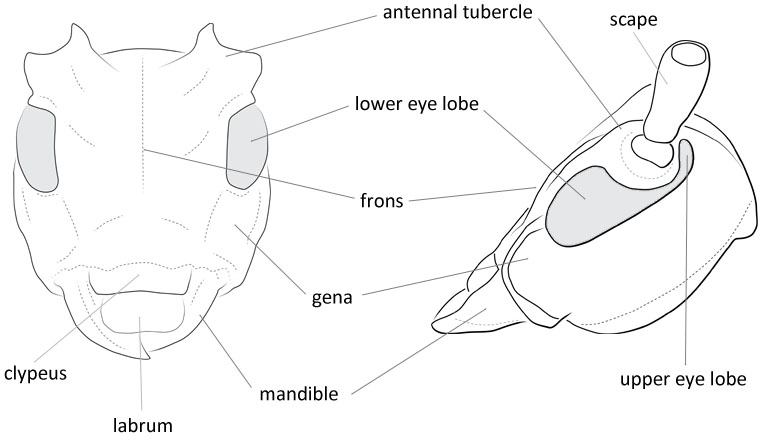Monochamus oregonensis latus Casey, 1924: 290
Length: 14–29 mm.
Elytral length:width ratio: length > 2x width.
Face: shape subquadratesubquadrate:
not quite a square
or wide rectangle; genagena:
the part of the cranium on each side below the eye length longer than lower eye lobeeye lobe:
length longer than lower eye lobeeye lobe:
used to refer to the upper or lower portion when the eye is emarginate or separated or subequal to lower eye lobeeye lobe:
or subequal to lower eye lobeeye lobe:
used to refer to the upper or lower portion when the eye is emarginate or separated .
.
Pronotum: dense setaeseta:
a sclerotized hair-like projection of the cuticle
on dorsum of lateral spines absent; maculaemacula:
a spot or mark
on pronotal disk: 2–4 dots present; posteromedial tubercletubercle:
a small knoblike or rounded protuberance
absent; lateral erect setaeseta:
a sclerotized hair-like projection of the cuticle
: present posterior and anterior to spinespine:
a protuberance with an acute (sharp) distal end
.
Scutellum: dense and complete pubescence or pubescence broken at least partially along midline.
Elytra: elytral integument color black; elytral maculaemacula:
a spot or mark
: dense velvety pubescentpubescent:
downy; clothed with soft, short, fine, loosely set hair
patches present or sparse ash-like pubescence; elytral sutural apexapex:
end of any structure distad to the base
dentate; elevation in basal third followed by impression absent; basal granulation dense and smooth; middle to apical punctationpunctation:
pits or depression of variable size in cuticle
coarse.
Antennal length (female): 2–3.5 segments beyond elytral apexapex:
end of any structure distad to the base
or >3.5 segments beyond elytral apexapex:
end of any structure distad to the base
.
Aedeagus: paramereparamere:
A pair of finger-like structures that are located where the male genitalia exits the abdomen.
mediobasal tooth present; apical tip (ventral view) truncatetruncate:
cut off squarely at the tip
or slightly rounded; scleritesclerite:
any hardened plate of the body wall bounded by membrane or sutures; sometimes found floating in the internal sac of male genitalia
in internal sac: scleritesclerite:
any hardened plate of the body wall bounded by membrane or sutures; sometimes found floating in the internal sac of male genitalia
absent.
Integument black, appendages black to dark reddish. Pubescentpubescent:
downy; clothed with soft, short, fine, loosely set hair
patches of elytraelytron:
the leathery forewing of beetles, serving as a covering for the hind wings, commonly meeting opposite elytron in a straight line down the middle of the dorsum in repose
dark brown to black, moderate-sized, numerous, interspersed gray pubescence abundant, forming numerous small spots. AntennaeAntenna:
in larval and adult insects, paired segmented appendages, borne one on each side of the head, functioning as sense organs and bearing a large number of sensilla
of females broadly white annulateannulate:
surrounded by a ring of a different color
. Underside rather sparsely clothed with small patches of gray appressed pubescence. Legs rather sparsely pubescentpubescent:
downy; clothed with soft, short, fine, loosely set hair
. Length, 14–29 mm. (Linsley and Chemsak 1984Linsley and Chemsak 1984:
Linsley EG and Chemsak JA. 1984. The Cerambycidae of North America. Part VII, No. 1. Taxonomy and Classification of the Subfamily Lamiinae, Tribes Parmenini Through Acanthoderini. University of California Press, Berkeley and Los Angeles. 258 pp.)
M. c. clamator has lighter integument and pubescentpubescent:
downy; clothed with soft, short, fine, loosely set hair
patches. M. scutellatus and M. obtusus have rounded elytral apicesapex:
end of any structure distad to the base
.
Sierra Nevada Mts. and northwestern USA into western Canada east to South Dakota
Abies, Pinus contorta, P. jeffreyi, P. monticola, P. ponderosa, Pseudotsuga menziesii (Titan DatabaseTitan Database:
Tavakilian GL and Chevillotte H. 2022. Titan: base de données internationales sur les Cerambycidae ou Longicornes. Version 3.0. Available from: http://titan.gbif.fr/ last accessed September 2022)
This subspecies is usually dark but can appear like a whitish M. c. clamator in southern Idaho.